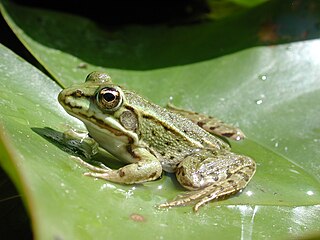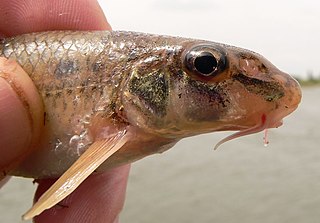Inga pauciflora, the guabita de río, is a species of plant in the family Fabaceae. The specific epithet pauciflora is Latin for 'few-flowered'. It is found only in Panama. It is threatened by habitat loss.

The South European nase is a species of cyprinid fish.

Chondrostoma soetta, or the Italian nase, is a species of freshwater fish in the family Cyprinidae. It is found in Italy, Slovenia, and Switzerland. Its natural habitats are rivers and freshwater lakes. It is threatened by habitat loss and predation and competition from introduced species such as roach, wels catfish and the common nase. It has been extirpated from Slovenia and numbers are declining in the Italian and Swiss lakes of Lake Como, Lake Lugano, Lake Maggiore, Lake Iseo and Lake Garda. Some population which are descended from fish introduced to other lakes in Italy appear to be thriving.

The white-finned gudgeon is a species of freshwater fish in the family Cyprinidae. It lives in the North Caspian basin in lower parts of the Volga and Ural River drainages. They can reach 13 cm in length.
Romanogobio elimeius is a species of ray-finned fish in the family Cyprinidae. It is found in Greece and North Macedonia. Its natural habitat is rivers. It is threatened by habitat loss.

The Kessler's gudgeon is a European species of freshwater fish in the family Cyprinidae. It is found in the Danube and Vistula drainage basins, including parts of Poland, Austria, the Czech Republic, Ukraine, Bulgaria, Romania, Moldova, Hungary, Croatia, Bosnia and Herzegovina, Serbia, Montenegro, Slovakia, and Slovenia. It is a small fish of no economic or sporting importance. It was at one time classified as Gobio kessleri.

Romanogobio uranoscopus, alternatively known as the Danubian longbarbel gudgeon, Danubian gudgeon, Danube gudgeon or the steingressling, is a European species of freshwater cyprinid fish. It can be found in Austria, Bulgaria, Croatia, Czech Republic, Germany, Hungary, Italy, Romania, Serbia and Montenegro, Slovakia, Slovenia and Ukraine.
Leptolaena pauciflora is a species of flowering plant in the Sarcolaenaceae family. It is found only in Madagascar. Its natural habitats are subtropical or tropical moist lowland forests, subtropical or tropical high-altitude shrubland, and sandy shores. It is threatened by habitat loss. The specific epithet pauciflora is Latin for 'few-flowered'.

The Italian pool frog is a species of frog in the family Ranidae. Found on the mainland of Italy and the Mediterranean islands of Sicily, Elba, Corsica and Sardinia, its natural habitats are rivers, swamps, freshwater lakes and freshwater marshes. It is not considered threatened by the IUCN.

The Italian edible frog is a hybridogenic species in the true frog family Ranidae. These frogs are the offspring of P. bergeri and either P. ridibundus or the edible frog which is itself of hybrid origin.
Brunellia pauciflora is a species of plant in the Brunelliaceae family. It is endemic to Ecuador. Its natural habitat is subtropical or tropical moist montane forests. It is threatened by habitat loss. The specific epithet pauciflora is Latin for 'few-flowered'.
Shorea pauciflora is a species of plant in the family Dipterocarpaceae. It is found in Sumatra, Peninsular Malaysia and Singapore. It is threatened by habitat loss. The specific epithet pauciflora is Latin for 'few-flowered'.

Romanogobio is a genus of cyprinid fish found in Europe and Asia.

The northern whitefin gudgeon is a species of freshwater fish in the family Cyprinidae. It is distributed in the northern Black Sea basin, southern Baltic Sea basin, southern North Sea basin. Also, reports from lakes Ilmen and Ladoga and its basins have been made, which are questionable. Their maximal length is 11.5 cm, with a maximal reported age of 5 years.
The Don whitefin gudgeon is a species of freshwater fish in the family Cyprinidae. It is distributed in the Don River basin in Russia, and also in the Siverskyi Donets River in Ukraine. The maximal length is 10.7 cm, maximal reported age 5 years.
Iris benacensis is a plant species in the genus Iris, it is also in the subgenus Iris. It is a rhizomatous perennial, from Italy. It has similar sized leaves and stem, and blue-purple shaded flowers, that have a white, blue and yellow beard. It was once classified as a synonym of Iris aphylla, before being re-classified as a species in its own right, although some sources still call it a synonym. It is cultivated as an ornamental plant in temperate regions.

Iris marsica is a plant species in the genus Iris, it is also in the subgenus Iris. It is a rhizomatous perennial, from the Apennine Mountains, in Italy. It has glaucous, sickle-shaped or curved, light green leaves, slender stem with 2 branches, and 3 violet, light blue violet, dark violet, and dark purple flowers. It was only found and described since 1973, and is not yet in general cultivation. It was once thought to be a form of Iris germanica, but has different morphological characteristics and different chromosomal differences.

For a small country, Albania is characterised by a considerable wealth of terrestrial and marine ecosystems and habitats with contrasting floral, faunal, and fungal species, defined in an area of 28,748 square kilometres. Most of the country is predominantly of Mediterranean character, comprehending the country's center and south, while the alpine affinity is more visible in the northeast.

The Danube delta gudgeon was a species of cyprinid fish endemic to the lower Danube in Romania and the Ukraine. It was last recorded in the 1960s, with many studies conducted in its home range, all failing to find the species.
The Kuban long-barbelled gudgeon is a species of cyprinid fish endemic to the middle reaches of the Kuban River in Russia














